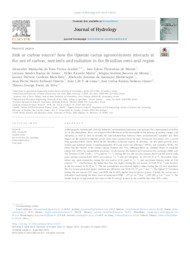Sink or carbon source? how the Opuntia cactus agroecosystem interacts in the use of carbon, nutrients and radiation in the Brazilian semi-arid region.
Sink or carbon source? how the Opuntia cactus agroecosystem interacts in the use of carbon, nutrients and radiation in the Brazilian semi-arid region.
Autoria: JARDIM, A. M. da R. F.; MORAIS, J. E. F. de; SOUZA, L. S. B. de; MARIN, F. R.; MOURA, M. S. B. de; MORELLATO, L. P. C.; MONTENEGRO, A. A. de A.; OMETTO, J. P. H. B.; LIMA, J. L. M. P. de; DUBEUX JÚNIOR, J. C. B.; SILVA, T. G. F. da
Resumo: Anthropogenic disturbances directly influence environmental processes and increase the concentration of carbon (C) in the atmosphere. Here, we compare the differences in the seasonality of the balance of carbon, energy, and radiation, as well as seek to identify the interrelationships between these environmental variables and their impact on the growth of Opuntia cactus. Data were acquired from an eddy covariance flux tower over a cactus crop agroecosystem (2019–2021) in the Brazilian semi-arid region. In addition, we use plant growth rates, carbon and nutrient stocks, evapotranspiration (ET) and water use efficiency (WUE), and radiation (RUE). We show that the closure of the surface energy balance was 71%, although there are minimal fluxes of available energy lost (29%) by unquantified processes. At all seasons, the highest net ecosystem CO2 exchange (NEE) rate was between 11:00–13:00 (?? 5.75 ?mol m?? 2 s?? 1). During the dry and wet-dry season, there was the lowest daily gross primary productivity (GPP) (2.5 ?mol m?? 2 s?? 1) and net radiation—Rn (217.97 W m?? 2). Ecosystem respiration was more expressive during the wet season (2.41 ?mol m?? 2 s?? 1), and maximum diurnal value of 2.65 ?mol m?? 2 s?? 1. Furthermore, the latent heat flux was higher during the wet season (114.68 W m?? 2) and lowered in the dry season (9.39 W m?? 2). The net assimilation rate showed higher values during the dry-wet transition. The dry season presented higher nutrient use efficiency and WUE (14.77 g m?? 2 mm?? 1). The highest ET occurred during the wet season (227 mm), and RUE was 81.48% higher than in the dry season. Overall, the cactus was a potential C sink during the three years of assessment (NEE: ?? 377 g C m?? 2 year?? 1; GPP: 881 g C m?? 2 year?? 1). The results help us to understand that most of the Rn energy is used in the sensible heat flux (58% ratio).
Ano de publicação: 2023
Tipo de publicação: Artigo de periódico
Unidade: Embrapa Semiárido
Observações
1 - Por padrão são exibidas publicações dos últimos 20 anos. Para encontrar publicações mais antigas, configure o filtro ano de publicação, colocando o ano a partir do qual você deseja encontrar publicações. O filtro está na coluna da esquerda na busca acima.
2 - Para ler algumas publicações da Embrapa (apenas as que estão em formato ePub), é necessário ter, no celular ou computador, um desses softwares gratuitos. Sistemas Android: Google Play Livros; IOS: iBooks; Windows e Linux: software Calibre.
Acesse outras publicações
Acesse a Base de Dados da Pesquisa Agropecuária (BDPA) para consultar o acervo completo das bibliotecas da Embrapa.

